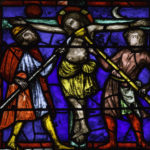We run our website the way we wished the whole internet worked: we provide high quality original content with no ads. We are funded solely by your direct support. Please consider supporting this project.
Was Jesus Violent in the Temple?
Many adopt the attitude depicted in the picture above, saying that Jesus used violence when he cleansed the temple. But Jesus’ stance on nonviolence is clear not only from how he responded to threatening enemies at the end of his life; it’s also strongly emphasized his teachings. We need to understand what Jesus was up to in the Temple in order to reconcile his actions with the cross and his teachings on non-violence.
We need to realize that the temple system of selling sacrificial animals to worshipers had become extremely corrupted in Jesus’ day. Among other abuses, priests were ripping people off by telling them the animal they bought to sacrifice didn’t meet their purity standards. People were thus forced to purchase a “temple certified” animal. The priests would then confiscate the allegedly substandard animal, only to turn around and sell it to the next worshiper who was told the animal they had bought was substandard. It was a money-making scam.
The Gospels tell us that Jesus was so enraged by this corruption that he made a whip, turned over tables, and drove animals and people out of the temple. God’s house was to be a house of prayer, he declared, not a den of thieves (Mark 11:17). On the precedent of this allegedly violent behavior, some have justified the use of violence “for righteous purposes” today.
I think this conclusion is completely unwarranted for three reasons.
First, we need to understand that Jesus wasn’t throwing an uncontrolled tantrum. Most scholars agree that this was a calculated prophetic, symbolic act on Jesus’ part. Based on Old Testament prophecy as well as the widespread knowledge of the corrupt priestly system, most Jews of Jesus’ day believed the coming Messiah was going to restore the temple and make it God’s house once again. By cleansing the temple, therefore, Jesus was demonstrating that he was the Messiah. He was also symbolically revealing Yahweh’s displeasure with the religious establishment of his day and symbolically acting out Yahweh’s reclaiming of his house.
It seems the masses understood the symbolism of Jesus’ actions. While his behavior enraged the religious leaders, the people responded by flocking to him (Mark 11:18).
Second, and closely related to this, most scholars agree that Jesus engaged in this aggressive behavior to force the hand of religious and political authorities against him. After all, he had come to Jerusalem with the expressed intention of being executed. Up to this point the Jewish authorities were concerned about Jesus, but they refrain from acting on their concern because of Jesus’ popularity with the crowds. By exposing their corruption, Jesus was now explicitly threatening their authority. And this forced them to start plotting his arrest and execution.
So, we again see that Jesus’ temple cleansing wasn’t a spontaneous outburst of anger. It was a premeditated, strategic act.
Third, and most importantly, while Jesus’ behavior was certainly aggressive, there’s no indication whatsoever that it involved violence. True, Jesus turned tables over. But this was to put an immediate stop to the corrupt commerce that was taking place as well as perhaps to free the caged animals. There’s no mention of any person or animal getting hurt in the process.
And yes, Jesus made a whip. But there’s no mention of him using it to strike any animal, let alone human. Cracking a loud whip has always been the most effective means of controlling the movement of large groups of animals. Jesus wanted to create a stampede of animals out of the temple, and there’s no reason to conclude he used the whip for any other purpose than this.
When we read this passage in context, we can see that, while Jesus was aggressive when he drove out the animals, we cannot use this passage as justification for violence.
Tomorrow, we will look at Luke 22:36-37, where Jesus tells the disciples to buy a sword, as many often refer to it as support for the use of righteous violence.
As MennoNerds, we all have found certain distinctives of Anabaptism to be central in our expression of faith. This article is part of a MennoNerds Synchro-Blog in the month of May on Anabaptism.
To find all the other articles in the Mennonerds on Anabaptism synchro blog click here.
Category: Q&A
Tags: Jesus, Mennonerds, Non-Violence, Violence
Topics: Enemy-Loving Non-Violence
Related Reading

The Challenge of Malala to the Church
http://youtu.be/f506lCk6Tos I don’t know if you’ve seen this, but it’s Malala Yousafzai appearing on Jon Stewart’s The Daily Show. At the age of 14 Malala was shot in the face at point blank range by the Taliban while riding to school on a bus, all because she wouldn’t stop speaking up for the right of…

The Perfect Love of God
The Father, Son and Spirit exist as the infinite intensity and unsurpassable perfection of eternal love. We know this about the triune God not by speculation but because Jesus demonstrated that love (Rom 5:8) in his willingness to go to the furthest extreme possible to save us. When the all-holy God stooped to become our…

God’s Warriors
Greg’s ideas on faith and politics were featured in the Peabody Award-winning CNN Presents: God’s Warriors. Watch the full video below. For more information, including behind the scenes footage, visit God’s Warriors – Special Reports from CNN.com.

Jesus: Our Vision of God
At the beginning of his Gospel John taught that “no one has ever seen God, but the one and only Son, who is himself God and is in closest relationship with the Father, has made him known” (Jn 1:18). He is claiming that, outside of Christ, no one has ever truly known God. In the…

Don’t all religions believe in the same God?
http://youtu.be/BKmSr6lKWsk Bruxy Cavey takes a swing at this question and scores a home run.

Gospel “Contradictions” and Orality Studies
* This essay has been adopted from G. Boyd and Paul Eddy, Lord or Legend? (Baker, 2007). One of the standard tests historians put to ancient documents to assess their veracity is self-consistency. Generally speaking, fabricated accounts tend to include more inconsistencies than truthful accounts. Hence, the absence of inner contradictions contributes to a positive…
